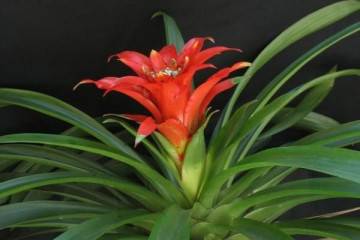Ginur flower - home care
Content:
The ginur flower is a plant from the Asteraceae family. There are over a hundred species of this plant. In the wild, it is common in the Asian and African tropics. The ancient Greeks called this flower "a woman with a tail" - this is how its name literally translates from this language. This name probably comes from the long stems. Some plant varieties are propagated exclusively for decorative purposes.
Description of the flower
This type of plant belongs to evergreen shrubs or grass with braided shoots, the length of which reaches several meters. The root is tuberous, fibrous. The stems can be hairy or hairless. Leaves are thin, thick and watery, naped or smooth. Below, the leaves often have a purple hue. Decorate the interior of a house or apartment with its unusual look.
The shape of the leaves is varied, they are:
- oblong,
- ovoid,
- delta-like,
- with and without cuts.
In addition, the leaves may have small or large cusps along the edges.
Red, orange, yellow, purple, purple flowers are collected in baskets - rare plant species can boast of such a variety in the palette. In its natural environment, flowering is observed almost all year round, especially violently - from December to June.
Flowers usually emit not the most pleasant, specific aroma. After flowering, the plant dies, which is also quite an interesting feature.
How the houseplant ginura blooms
Ginura is a flower that grows quite quickly. There are varieties that are specially cultivated with large sizes and long stems. Some varieties can be poisonous and should be handled with care and kept away from pets.
The most common types for indoor cultivation are variegated ginura, purple ginura and climbing (or climbing).
Ginur flower: home care
Lighting
For a plant to bloom, it needs bright light. A suitable place is a windowsill by a window facing west (or, if possible, south). In this case, during the day, the flower must be shaded so that the plant does not burn out.
In winter, when there is less light, artificial lighting is needed.
Priming
The flower needs a loose, drained, neutral soil. For example, a substrate with equal proportions of turf, humus, leaves, soil is well suited, and a little sand should be added there.
Air temperature
From the point of view of temperature conditions, it is not difficult to care for the plant. The recommended summer temperature range is 18 to 24 ° C.
In winter, the temperature must not be reduced when artificial lighting is on. In the absence of additional illumination, the plant needs a temperature regime of 12 to 14 ° C - in this case, the ginura goes to rest and rests.
Watering
During periods of growth, it requires abundant watering. Water should be added every time the top layers of the soil in the pot are dry. In winter, during the rest of the plant, the intensity of watering must be reduced so that it does not collect excess moisture.
If artificial lighting is on, watering should remain “warm”. You need to use clean, settled water. Water gently so that no drops of water remain on the leaves.
Air humidity
The flower is unpretentious to humidity and blooms in almost any climate. However, in winter, when the air is very dry due to the active operation of the radiators, it is better to place the pot on a tray with wet clay, water or pebbles.
Pruning
Ginura needs to be pruned for it to bloom. You can do this after the winter rest. If the plant is pruned in another season, it will accelerate the growth of shoots, increase bushiness. All you have to do is trim the tops of the shoots.
Top dressing
During periods of growth, it is advisable to fertilize the soil with complex mineral fertilizing twice a month. For this purpose, the usual complex formulations from the store are quite suitable.
During rest periods, fertilizers are not needed, they will interfere.
Transfer
If necessary, the transplant should be carried out in the spring. Only young flowers retain the purple hue of the leaves, so it is worth planting and propagating flowers every two years.
Ginura breeding
In spring or summer, cut off the top of the stem and place in water. After a few weeks, the shoot will take root and can be transplanted into a pot.
Pests and diseases
Despite the fact that the plant has a fairly good immunity to diseases, pests may appear due to insufficient or, moreover, improper care. In this case, sometimes there are:
- shield,
- aphid,
- powdery bug
- whitefly,
- spider mite.
The scale insects catch on the leaves of the plant - from this they turn yellow, wither. Further, the ginura stops growing and may even die.
Whiteflies - the so-called white moths - can lay eggs on the leaves of the plant. From them, larvae appear, which drink the juice from the shoots, which negatively affects the growth and health of the flower.
The mealybug drinks the juice of the plant. It betrays itself by the characteristic "cotton" traces of white, which remain on the leaves, sometimes even flowers and stems. The flower stops growing.
Ticks also love plant sap. Small dots under the leaves (color - white), thin, barely noticeable cobwebs will betray their presence. In addition, ticks carry incurable viral infections that are dangerous to humans and pets.
Aphids are insects that also carry viruses.
Special preparations that are sold in flower shops will help get rid of pests if necessary. The owner of ginura can only determine who infected the plant and choose the appropriate medicine.
Useful properties of ginura
Certain types of ginura that grow in the wild have been known for their medicinal properties for over a century.
So, ginura pinnate is an expensive and rather rare flower that is grown in China for industrial purposes. The flower contains various polysaccharides, oils, many amino acids and useful trace elements.
Ginura is very popular in China, America and Japan. Eating the leaves of this plant for food (about 2-3 leaves before meals in the morning, or as part of a salad) will improve health and tone: strength will appear, blood glucose levels, cholesterol levels and blood pressure will decrease. Ginura is also believed to help you lose weight.
Signs and superstitions
This plant is said to cleanse the house of evil spirits and bad energy (despite the foul smell of its flowers). And the soft leaves of the plant can soften the rough nature of a person.
They also say that unpleasant-smelling flowers will save love hearts from mistakes, so there is no need to break buds and shoots.
It is also believed that ginura brings female happiness to the home.
Common varieties
Not very many types of ginura are grown as a home ornamental plant. The most common are: prostrate, orange or braided ginura.
- Orange ginura (aurantiaca / aurantika)
The evergreen shrub sometimes reaches a height of up to one meter, shoots and bush leaves are covered with purple fibers. The lower leaves are ovoid, the upper ones are petiolate, pointed at the sides and small.
The flowers are also small and collected in bunches: bright orange or golden yellow. The greatest distribution is observed on the island of Java.
- Ginura wicker sarmentosa
Twisting shoots with small leaves in length reach about 60 cm. Its homeland is East Africa.
This species looks great and grows well as an ampelous plant.
- Ginura climbing, or climbing, scandens
This species grows well in a greenhouse. Leaves are oval and large, with small notches. The stems can be up to two meters in length.
- Peristoncutting ginura
Climbing shoots, ribbed. The stalks are 45 mm in diameter. Grown in the cool.
- Ginura prostrate (gynura procumbens or ginura procumbens)
Green bush with nesting shoots, stems grow up to six meters. The plant is loved and respected in eastern countries such as China, Indonesia and Japan. There it is widely used as a medicinal product.
In some cases, its leaves are used as an ingredient in various dishes. The plant does not pose a danger to pets and people. In the same places there is another medicinal type of flower - gynura nepalensis.
Ginura is a very beautiful flower, and some of its species that grow in the wild are also useful. Wild varieties can be eaten and used as medicines. Indoor views will decorate the home, cleanse the house of evil spirits (according to folk signs). The plant is very easy to care for, the main thing is to monitor the temperature and humidity of the air.























